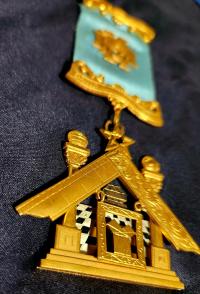The Past Master’s Jewel
16 January 24
There is no higher, and theoretically, more important office in a lodge than that of the Worshipful Master.
The Jewel of Office he wears is a Builder’s Square beneath which is fixed a perfect square containing the illustration of Euclid’s 47th Proposition, the perfect square being the masonic symbol of moral perfection. It is the Master’s duty to apply the perfect square of right and truth to the work of the lodge, himself exemplifying what is Right and what is Truth in the conduct of his lodge.
The award of a jewel to the retiring Worshipful Master of a lodge was first officially proscribed in the first Book of Constitutions following the unions of English lodges in 1815. The Jewel was to be ‘that of a Square and the diagram of the 47th Proposition of Euclid engraved on a silver plate pendent within it’. History tells us that Dr Anderson, author of the 1723 and later 1738 ‘Constitutions’ used this design as the front piece of both historical documents.
The pendent of the 47th Proposition beneath the Square worn by the Master was intended as symbolic of the importance of geometry in the designing of buildings and the mason’s trade. The ‘Old Charges’ to which every new Masonic Master must assent, have been historically closely linked to the mason’s craft.
Dr Anderson in his 1723 Constitution averred that ‘the 47th Proposition of Euclid’s first book is the foundation of all Masonry, sacred, civil and military’. He was treating the 47th Proposition as ‘the symbol of all geometry and proclaiming the age-old link between science and the Craft’.
The 47th Proposition states the proof in every right angle triangle, the sum of the squares of two sides is equal to the sum of the hypotenuse. Thus the measurement of the triangle in the Past Master’s jewel is the traditional 3-4-5, and the lines of proof of the Proposition are shown on the completed symbol.
Ancient buildings were designed in any of three forms – square, oblong 2 to 1 or oblong 3 to 1. If a building was to be square, distances were measured from the centre point to each of the four corners. This was done by the Master Masons carrying 2-4-5 rods who would then mark out right-angle corners of the new building.
In operative times, the main secret of Operative Guild Masonry was that the Master of the Lodge carried a rod measuring three units. His senior warden carried a similar rod measuring four units and the junior warden carried one measuring five units. When joined together they formed a perfect right-angle triangle. When a temple or public building was being constructed for the King or Ruler, on a date arranged the King ceremoniously laid the centre stone, then with a centre punch made a Centre Mark on the stone with a blessing. This mark became the ‘point from which a person could not err’.
The Master and Wardens then formed four right-angle triangles from the centre point, at the corners of which pegs were placed. Lines were then extended a safe distance from the corners to form permanent Land Marks of the Order from which all future measurements of the future building would be made.
It was then a criminal offence, punishable by death, to alter or remove the Land Mark from buildings under construction as it was from these Land Marks that all measurements required in the construction of the building were made.
Much has been written on the Past Master’s Jewel. The consensus view is that the jewel is not a symbol but rather it alludes to the 47th Proposition which is universally proclaimed as the ‘quintessence of perfection and truth’. Masonry ‘is an art founded on the principles of geometry and directed to the service of mankind’.
Historically, these symbols, while veiled in allegory, were directed to the noble object of cultivation of improvement in the human mind in the purest principles of morality. The moral philosophy of the right angle of a triangle represents the equal balance of spiritual and physical forces so that neither will prove a deterrent to the other. The hypotenuse represents the bond of union which connects the spiritual and the physical on each end of the line. The extreme points at the end of the line hypotenuse represent the soul, body and spirit.
In masonic constitutions other than England, the Past Master’s jewel had a different design beneath the inverted square of the Master’s jewel. The Scottish jewel illustrates the fundamental importance of geometry in ancient Masonry while the Irish reflects the strong spiritual history of Freemasonry in Ireland. Indeed the oldest true relic of Freemasonry is a brass square found in the foundations of Baal’s Bridge near Limerick, dated 1507 on which is inscribed the words: ‘I will strive to live with love and care, upon the level, by the square.’


By W Bro Reg Whiteley


